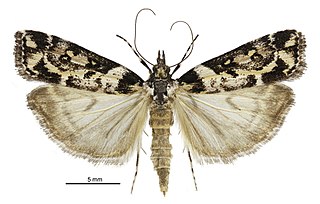
Eudonia diphtheralis is a species of moth in the family Crambidae. It is endemic to New Zealand.

Pyroderces aellotricha, also known as the Cosmet moth, is a moth of the family Cosmopterigidae. It is found in New Zealand, in Australia and the Cook Islands.

Ichneutica scutata is a moth of the family Noctuidae. It is endemic to New Zealand. This species can be found in the southern parts of the North Island as well as the eastern parts of the South Island. It is similar in appearance to I. insignis and I. skelloni but can be distinguished as I. scutata is much paler in appearance. It is likely this species inhabits lowland tussock grasslands as well as coastal dunes although it is not common in inland tussock grasslands. The larvae feed on a variety of herbaceous plants such as Plantago and Convolvulus species, Plagianthus divaricatus. It pupates on soil near its host plants. The adults are on the wing from late March to July.
Thiotricha clidias is a moth of the family Gelechiidae. It was described by Edward Meyrick in 1908. It is found in Sri Lanka and Assam, India.
Aeolanthes dicraea is a moth in the family Depressariidae. It was described by Edward Meyrick in 1908. It is found in India (Assam).
Eutorna intonsa is a moth in the family Depressariidae. It was described by Edward Meyrick in 1906. It is found in Australia, where it has been recorded from Victoria, New South Wales and Tasmania.
Imma auxobathra is a moth in the family Immidae. It was described by Edward Meyrick in 1906. It is found on Borneo and in Nepal.
Imma cancanopis is a moth in the family Immidae. It was described by Edward Meyrick in 1906. It is found in Colombia and French Guiana.
Imma chasmatica is a moth in the family Immidae. It was described by Edward Meyrick in 1906. It is found in the Indian states of Sikkim and Assam.
Imma dioptrias is a moth in the family Immidae. It was described by Edward Meyrick in 1906. It is found on New Guinea.
Imma epicomia is a moth in the family Immidae. It was described by Edward Meyrick in 1906. It is found on the Solomon Islands.
Bursadella grammatistis is a moth in the family Immidae. It was described by Edward Meyrick in 1906. It is found on New Guinea.
Imma hyphantis is a moth in the family Immidae. It was described by Edward Meyrick in 1906. It is found in Sri Lanka.
Imma nephallactis is a moth in the family Immidae. It was described by Edward Meyrick in 1906. It is found in Venezuela.
Imma otoptera is a moth in the family Immidae. It was described by Edward Meyrick in 1906. It is found on Borneo.
Imma thyriditis is a moth in the family Immidae. It was described by Edward Meyrick in 1906. It is found on the Solomon Islands.
Imma lyrifera is a moth in the family Immidae. It was described by Edward Meyrick in 1910. It is found on New Guinea and Australia, where it has been recorded from Queensland.
Imma halonitis is a moth in the family Immidae. It was described by Edward Meyrick in 1920. It is found in Chennai, India.
Imma synconista is a moth in the family Immidae. It was described by Edward Meyrick in 1918. It is found in Kanara, India.
Imma nephelatma is a moth in the family Immidae. It was described by Edward Meyrick in 1927. It is found in New Guinea.


